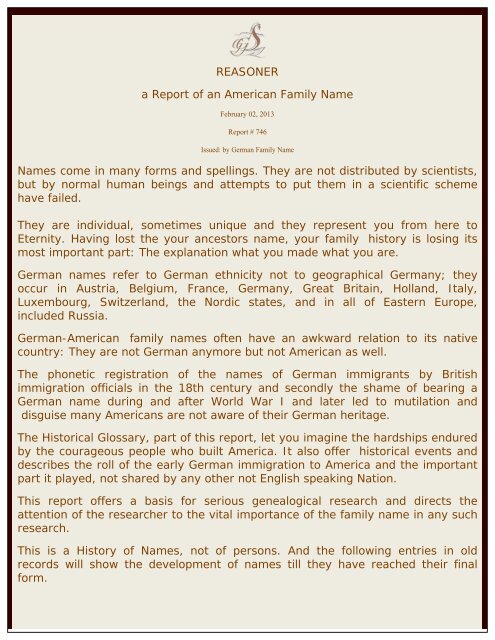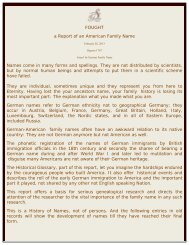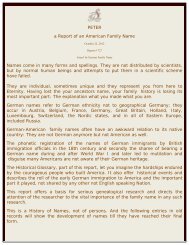Reasoner - German Genealogical Services
Reasoner - German Genealogical Services
Reasoner - German Genealogical Services
Create successful ePaper yourself
Turn your PDF publications into a flip-book with our unique Google optimized e-Paper software.
REASONERa Report of an American Family NameFebruary 02, 2013Report # 746Issued: by <strong>German</strong> Family NameNames come in many forms and spellings. They are not distributed by scientists,but by normal human beings and attempts to put them in a scientific schemehave failed.They are individual, sometimes unique and they represent you from here toEternity. Having lost the your ancestors name, your family history is losing itsmost important part: The explanation what you made what you are.<strong>German</strong> names refer to <strong>German</strong> ethnicity not to geographical <strong>German</strong>y; theyoccur in Austria, Belgium, France, <strong>German</strong>y, Great Britain, Holland, Italy,Luxembourg, Switzerland, the Nordic states, and in all of Eastern Europe,included Russia.<strong>German</strong>-American family names often have an awkward relation to its nativecountry: They are not <strong>German</strong> anymore but not American as well.The phonetic registration of the names of <strong>German</strong> immigrants by Britishimmigration officials in the 18th century and secondly the shame of bearing a<strong>German</strong> name during and after World War I and later led to mutilation anddisguise many Americans are not aware of their <strong>German</strong> heritage.The Historical Glossary, part of this report, let you imagine the hardships enduredby the courageous people who built America. It also offer historical events anddescribes the roll of the early <strong>German</strong> immigration to America and the importantpart it played, not shared by any other not English speaking Nation.This report offers a basis for serious genealogical research and directs theattention of the researcher to the vital importance of the family name in any suchresearch.This is a History of Names, not of persons. And the following entries in oldrecords will show the development of names till they have reached their finalform.
1. Spelling Variations of the Family name:Names change upon moving into a new linguistic environment, like in case of immigration, and its adoptions in some cases do not remember the original. Also<strong>German</strong> Immigrants and their descendants found it often desirable to hide the connection to their <strong>German</strong> Homeland (check Historical Glossary for furtherinformation). The resulting names look completely English and since nothing in the spelling of their names suggests their <strong>German</strong> origin, their bearers nowadays veryoften are not aware of their <strong>German</strong> origins (Dictionary of American Family Names, page IV)Structure of name information:An American family name in its original form, which appears in the U.S.U.S. NameCensus more than hundred times. If the field "U.S. Name" is blank afterentering a name, that means this specific name appears less than hundred timesin the census.U.S. Ranking Shows the rank of a specific name between 1 and 151,671.U.S. Count Number of persons bearing this name in the United States.U.S. White Percentage of people with this name who are of Caucasian heritage.Categories Classifies names in different ethnic groups.Equivalent NameA name of a foreign ethnicity other than U.S., which could be the same if itwas misspelled or translated from its original form.<strong>German</strong> Rank Shows the rank of a specific name between 1 and 306,001.<strong>German</strong> Count Number of persons bearing this name in <strong>German</strong>y.ClusteredRefers to a region or city in <strong>German</strong>y where most people with this namelived in 2009Location Link to city or region where name is clustered, (this feature is under construction).US Name US Ranking US Count US White Categorie Surname <strong>German</strong> Ranking <strong>German</strong> Count Clustered LocationREASONER 14176 1944 93.72 <strong>German</strong> Root Riesener 3142 133 3 05:35.9RISENER 143847 106 93.4 <strong>German</strong> Root Riesener 3142 133 3 05:35.9
2. Passengers ListAt different periods, various causes and diverse motives induced <strong>German</strong>s to abandon their homeland. Since 1606, millions have emigrated. Religious persecutionand political oppression drove thousands to Pennsylvania, an asylum for the harassed and depressed sons and daughters of the Reformation. William Penn himselfinvited the persecuted of every creed and religious opinion to settle. From 1682 to 1776, Pennsylvania was the central point of immigration from <strong>German</strong>y, Franceand Switzerland. Penn's liberal views, and the illiberal course of the government of New York toward <strong>German</strong>s, induced many to come to this province. (Rau)Our passenger lists represent 356 ships, most of which sailed from Rotterdam to Philadelphia. (Check the Historical Glossary for further information.)Structure of passenger information:Num Ships number in the ships list, reference to details of a certain voyageVessel Type different vessel types, check Historical Glossary , “The voyage” for detailed informationArrival date date format: year-month-dayMaster Captain of the vesselIntinerary route of the vessel, check Historical Glossary for table (example: R-C-P, Rotterdam-Cowes-Philadelphia)Total passengers shipped, the ships gives in some cases a specification for sex and ageRemarks self explanatoryNee maiden name of the wifeIlit illiterate, can not read or writeR indentured servant or redemptioner, check Historical glossarySourceRupp, Daniel, A collection of upwards of thirty thousand names of <strong>German</strong>, Swiss, Dutch, French and other immigrants in Pennsylvania from1727-1776, this book is available in our Library for a free down loadArrival DateNum Ship Name Vessel Type Master Itinerary Total Remarks(yyyy-mm-dd)26 Dragon Ship 1732-09-30 Charles Hargrave R-D-P 183Surname Nee First Name Middle Name Born Sex Ilit R Speeling Variations From To NotesReisner Hans Michel MShip49 Charming Polly Ship 1737-10-08 Charles Stedman R-P-P 237Surname Nee First Name Middle Name Born Sex Ilit R Speeling Variations From To NotesReisner Leonard M SickShip102 St Andrew Ship 1743-10-07 Robert Brown R-C-P 82Surname Nee First Name Middle Name Born Sex Ilit R Speeling Variations From To NotesReysner Phyt MShip129 Christian Ship 1749-09-13 Thomas Brady R-C-P 300 From Alsace and ZweibrueckenSurname Nee First Name Middle Name Born Sex Ilit R Speeling Variations From To NotesRessener Joseph MShip189 Phoenix Galley 1752-11-02 John Spurrier R-P-P 194Surname Nee First Name Middle Name Born Sex Ilit R Speeling Variations From To NotesReisner Johann Caspar MGalley213 Barclay Ship 1754-09-14 John Brown R-C-P 109 from Alsace and Lorraine
Surname Nee First Name Middle Name Born Sex Ilit R Speeling Variations From To NotesReisener Tobias MShip311 Montague Ship 1773-12-08 William Pickels L-P 26Surname Nee First Name Middle Name Born Sex Ilit R Speeling Variations From To NotesRissner Jacob MShip315 Union Ship 1774-09-30 Andrew Bryson R-C-P 131Surname Nee First Name Middle Name Born Sex Ilit R Speeling Variations From To NotesReutzheiner Johan Carl MShip413 Mary Brig 1788-08-05 Ams-PhaSurname Nee First Name Middle Name Born Sex Ilit R Speeling Variations From To NotesRitzener Mararethe FBrigBilanderBrigGalleyA Bilander, also spelled billander or be'landre, was a small European merchant ship with two masts, used in the Netherlands for coastand canal traffic and occasionally seen in the North Sea but more frequently to be seen in the Mediterranean Sea. The mainmast waslateen-rigged with a trapezoidal mainsail, but the foremast carried the conventional square course and square topsail. Displacement wastypically under 100 tons. The Bilander was short-lived, being replaced by more efficient designs, and few examples exist today.In nautical terms, a brig is a vessel with two square-rigged masts. During the Age of Sail, brigs were seen as fast and maneuverable andwere used as both naval war ships and merchant ships. They were especially popular in the 18th and early 19th centuries. Brigs fell outof use with the arrival of the steam ship because they required a relatively large crew for their small size and were difficult to sail into thewind. They are not to be confused with a brigantine which has different.The word "schooner" comes since 1419 from <strong>German</strong> texts. The later meaning galley for a "two-master with high foremast" is notfound before 1748 for the Dutch, Danes, Swedes and <strong>German</strong>s schooner means a vehicle with a rake and his flat tail, which has a largeboom and a small mizzen mast. A distinction is made between Huker Slupgaleasse and, depending on whether the main mast riggedlike the Schooner brigg.A small tender ship, which normally links two ports.PacketPinkShipIn the Atlantic Ocean the word pink was used to describe any small ship with a narrow stern, having derived from the Dutch wordpincke. They had a large cargo capacity, and were generally square rigged. Their flat bottoms (and resulting shallow draught) madethem more useful in shallow waters than some similar classes of ship. They were most often used for short-range missions in protectedchannels, as both merchantmen and warships. A number saw service in the English Navy during the second half of the 17th CenturyGalley:Full rigged ships: The masts of a full rigged ship, from bow to stern, are: • Foremast, which is the second tallest mast • Mainmast, thetallest • Mizzenmast, the third tallest • Jiggermast, which may not be present but will be fourth tallest if so If the masts are of wood,each mast is in three or more pieces. The lowest piece is called the mast or the lower. Above it, the pieces in order are • Topmast •Topgallant mast • Royal mast, if fitted .Most Immigrants arrived with this type
SnowA snow (pronounced "snoo") or snaw, is a sailing vessel[1]. A type of brig (snows are often-referred to as "snow-brigs"), snows wereprimarily used as merchant ships, but saw war service as well. The twin brigs Lawrence and Niagara, American warships of the Battleof Lake Erie, were both snows. Snows carried square sails on both masts, but had a small trysail mast, sometimes called a snow mast,stepped immediately abaft the mainmast. This mast could carry a trysail with a boom, with the luff of the trysail hooped to it.Sometimes, instead of a trysail mast, snows carried a horse on the mainmast, with the luff of the trysail attached to it by rings.
4. Land Deeds of West VirginiaList of land deeds claimed and registered by authorities in the 18th and 19th century in West Virginia. The registration was made by year of entry, Volume andpageStructure of land deeds of West Virginia:Reference Reference NumberName of grantee Family nameAdditional info like & co, and company, a number reference in this column means joint ownership with this numberNumber possibly volume, no information availablePage page numberSource Dyer’s Land Grants in West Virginia, volume 1 & 2 .These books are available in our Library section for a free download.Name of grantee FirstName Additional info State County Acres Location Year Number PageReasner Jacob West Virginia Greenbrier County 127 W side Patterson's cr 1781 3 584<strong>Reasoner</strong> Henry West Virginia Greenbrier County 418 Patterson's creek- 1789 0 381<strong>Reasoner</strong> Jacob West Virginia Greenbrier County 118 N branch Potomac 1789 0<strong>Reasoner</strong> Jacob West Virginia Greenbrier County 113 Patterson's ereek 1789 3Rozener Gideon West Virginia Greenbrier County 0 Middle ridge 1789 1 314
<strong>Reasoner</strong> Riesener Garret 1782<strong>Reasoner</strong> Riesener Jacob 1782* * * END OF REPORT * * *








